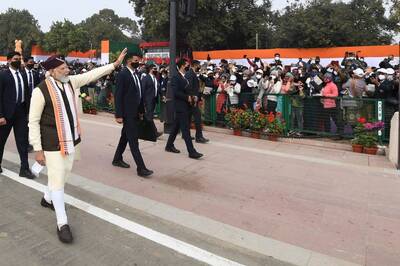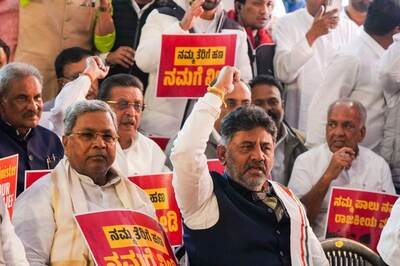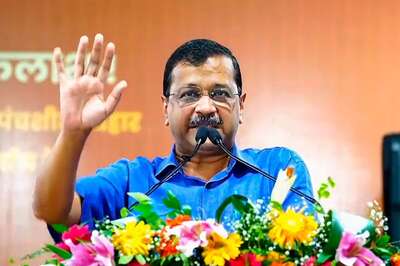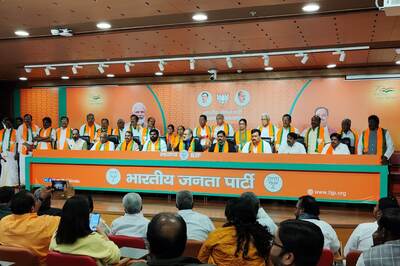
views
For the first time in at least a decade, an army soldier was killed in a stone pelting incident in Kashmir. The death of 22-year-old sepoy Rajendra Singh, on Friday, drew some very sharp words from the Army Chief Gen Bipin Rawat, who described stone pelters as Over Ground Workers (OGWs) of terrorists.
“If they (stone pelters) can kill people with such acts, are they not becoming like terrorists,” he said and assured of taking tough measures against such acts.
Violence in the already restive state of J&K is increasing at an alarming rate. Since last Sunday at least 23 people, including civilians, security forces and militants, have been killed in the Valley. Within this month alone, which has still not ended, 59 people - 31 militants, 14 civilians, 14 forces personnel - have lost their lives. Body bags are mounting by the day.
In terms of deaths in a month, this October is second only to July 2016, when Burhan Wani was killed and 62 people were killed in clashes following his death.
Some of the top-ranking security officers deputed in the valley told News18 that the frequency of encounters in Kashmir has increased because of the upcoming Panchayat polls and winter season. Sources told News18 that with Panchayat polls having a history of attracting the ire of militant groups, forces are trying to eliminate and debilitate them well before the polls. Second, the forces are interested in launching maximum number of operations just before the onset of winters when movement and vision are restricted by heavy snowfall.
“When a militant is killed, particularly a high-ranking one, their ranks feel perturbed and they make some movements. This reaction sometimes leads to good human intelligence and subsequently, more operations are launched. This is what’s happening in Kashmir right now,” said a senior J&K police officer on the condition of anonymity.
After the killing of a militant, it is now a “sort of norm”, said a source, that his fellow militants visit his funeral to offer a gun-salute. Having eyes on them in these funerals, the source added, is also helping agencies to get a sense about the area-wise presence of militants. Officials also believe that killing of a militant makes it easy to launch more operations.
Additional Director General of Jammu and Kashmir Police (ADGP) Muneer Khan, who looks at law and order of the state, says the increase in the operations is only because of the good intelligence.
“The primary thing that makes the operations successful is the good intelligence input. We don’t need to dramatise the situation. Forces are working as they have to, there is nothing extraordinary in it,” Khan told News18.
Killings and increasing alienation
Several political leaders have expressed anguish at the alarmingly high number of killings in Kashmir.
After the killing of seven civilians in Kulgam, last Sunday, former Chief Minister of the state, Omar Abdullah, stressed that the ground realities of Kashmir cannot be overlooked. “Alienating the people in the fight against militancy is a surefire recipe for losing the fight. How long can we go on ignoring the ground realities & living in denial about how bad things are in Kashmir?” he wrote on Twitter.
Many blame the present spell of violence on the dysfunctional political setup in the valley.
“State violence has increased because tenacity of political assertion from young Kashmiris hasn't waned since last eight years,” said Tahir Firaz, a Kashmiri political science scholar at Dublin City University.
“State wants to subdue the youth-led rebellion, but despite bearing heavy casualties militant recruitment hasn't stopped and this leads to frequent gun-fights, where poorly trained new recruits get killed and the state forces face minimum damage,” he said.
Responding to violence with more violence cannot be the dictum of how democracies engage with alienated masses, says PDP’s spokesperson, Najmu Sakib.
He says, “Our future generation is being consumed in the vicious vortex of violence and bleakness. The government and the governed cannot be perpetually at war with our future.”
With the intensification of anti-militancy operations on the ground, things don’t seem to change in Kashmir. The vicious cycle of violence keeps growing and the number of protests and the participation of people in the funerals is not decreasing.
"The spike in the offensive against militants tells one thing that state has now decided to neutralise militancy as soon as possible,” says Faizan Wani, a student at the University of Kashmir. “However, the response from the public in the form of funerals and protests shows the current spell of the public uprising will take longer to tire out.”
Like others, Faizan also blames Delhi’s stubbornness.
“The intransigence maintained by the state with regards to the larger political issue is pushing people to resist vociferously,” he added.
Over the last 10 months, 472 people have died in encounters and clashes in Jammu and Kashmir, as per the data collected by a civil rights group - Jammu Kashmir Coalition of Civil Society (JKCCS). The figures state that 207 militants were killed till October, during the same period 131 civilians and 132 security personnel lost their lives.
In other words, a militant is killed every 14 hours in Kashmir on an average. Similarly, one civilian and one security force personnel lose their lives every second day.
This figure, of violence related fatalities in the state in the first 10 months of the year, when compared to the casualty figures for the whole of 2017 - a total of 379 deaths, 100 of which were security personnel, 177 were militants and 102 were civilians - gives one an idea of how rapidly is the violence in Kashmir spiralling out of control. There is a 24% increase in the number of casualties. But there is no doubt that even in this heightened period of unrest, the month of October has been remarkably bloody.
Month-wise casualty figures by JKCSS
January 39
February 34
March 47
April 56
May 51
June 53
July 30
August 53
September 54
October 58




















Comments
0 comment